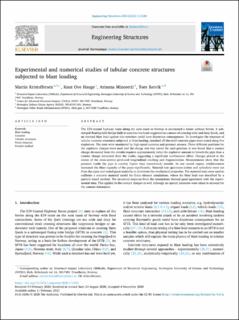| dc.contributor.author | Kristoffersen, Martin | |
| dc.contributor.author | Hauge, Knut Ove | |
| dc.contributor.author | Minoretti, Arianna | |
| dc.contributor.author | Børvik, Tore | |
| dc.date.accessioned | 2021-10-21T07:52:16Z | |
| dc.date.available | 2021-10-21T07:52:16Z | |
| dc.date.created | 2021-04-14T15:40:28Z | |
| dc.date.issued | 2021 | |
| dc.identifier.citation | Engineering structures. 2021, 233, 1-21. | en_US |
| dc.identifier.issn | 0141-0296 | |
| dc.identifier.uri | https://hdl.handle.net/11250/2824351 | |
| dc.description.abstract | The E39 coastal highway route along the west coast in Norway is envisioned a future without ferries. A submerged floating tube bridge built in concrete has been suggested as a means of crossing wide and deep fjords, and an internal blast load against this structure could have disastrous consequences. To investigate the response of tubular concrete structures subjected to blast loading, standard off-the-shelf concrete pipes were tested using live explosives. The tests were monitored by high-speed cameras and pressure sensors. Three different positions for the explosive charges were used and the charge size was varied for each position. It was found that a contact charge detonated from the outside requires approximately twice the explosive amount to breach the pipe than a contact charge detonated from the inside, suggesting a significant confinement effect. Charges placed in the centre of the cross-section produced longitudinal cracking and fragmentation. Measurements show that the pressure inside the pipe is notably higher than immediately outside. As one would expect, reinforcement increased the blast capacity of the pipes significantly. Material test specimens (cubes and cylinders) were cut from the pipes and tested quasi-statically to determine the mechanical properties. The material tests were used to calibrate a concrete material model for finite element simulations, where the blast load was described by a particle-based method. The structural response from the simulations showed good agreement with the experimental data. This applied to the contact charges as well although no special measures were taken to account for the contact detonation. | en_US |
| dc.language.iso | eng | en_US |
| dc.publisher | Elsevier Science | en_US |
| dc.rights | Navngivelse 4.0 Internasjonal | * |
| dc.rights.uri | http://creativecommons.org/licenses/by/4.0/deed.no | * |
| dc.title | Experimental and numerical studies of tubular concrete structures subjected to blast loading | en_US |
| dc.type | Peer reviewed | en_US |
| dc.type | Journal article | en_US |
| dc.description.version | publishedVersion | en_US |
| dc.source.pagenumber | 1-21 | en_US |
| dc.source.volume | 233 | en_US |
| dc.source.journal | Engineering structures | en_US |
| dc.identifier.doi | 10.1016/j.engstruct.2020.111543 | |
| dc.identifier.cristin | 1904086 | |
| dc.source.articlenumber | 111543 | en_US |
| cristin.ispublished | true | |
| cristin.fulltext | original | |
| cristin.qualitycode | 2 | |

